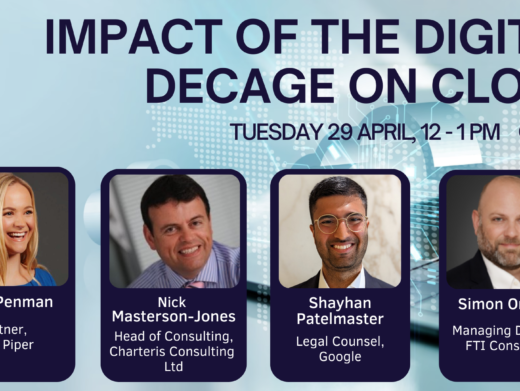{b}From Matthew Davis (Litigation Support Lawyer) and Bill Onwusah (Litigation Support Manager), Hogan Lovells International LLP{/b}
Solicitors who have resolutely failed to educate themselves about PD 31B and all that it entails will find themselves on the sharp end of proactive case management decisions made by better trained judges, encouraged by those solicitors who now understand electronic disclosure (or who at least know a litigation support provider who does). However, those who still do not understand ESI and/or who view disclosure as an opportunity to gain a strategic advantage will for now still be able to make life difficult and unnecessarily expensive for everyone else. October 2012’s expected costs management revolution, and the need to prepare a budget for the litigation that covers disclosure, may yet provide the silver bullet.
The cloud will more frequently be a source of disclosable documents. There will be a commensurate increase in the number of organisations who live to regret not including Legal in IT’s negotiation of the contract with their cloud service provider. Although the collection of ESI from portable devices and social networking sites will need to be considered more often, that will not necessarily mean a huge growth in the amount of data that is actually collected and reviewed from these sources. This is because it will often not be relevant to the case at hand, will be duplicative of ESI that will be collected from a more readily accessible source or will be outside of the boundaries of a reasonable search. However, where social media is disclosable this is going to present real challenges, particularly where the data is held by a third party and/or is no longer available.
At the information management/litigation readiness end of the spectrum, many organisations will continue to fail to consider whether and, if so, how to deal with social media and other new types of ESI prior to a dispute arising. Instead this will be added to the same permanent ‘to do’ list as creating, implementing and maintaining a clear and up-to-date document retention policy for all the ESI the organisation already has.
The industry’s recent focus on predictive coding and the publicity given to the studies that show that it is at least as good as (or, given some of the statistics, as bad as?) human review will encourage more to try it. In a litigation support Nirvana, the parties would cooperate in the selection of the documents that would then be used by them both to train their respective predictive coding tools. In reality, lawyers will continue to default to the traditional approach of keyword searches followed by a human review unless such an approach is not practically or financially viable.
From Carolyn Bigg, Managing Associate – Information, Communications and Technology, Simmons & Simmons (based in Hong Kong, Carolyn offers an Asian perspective)
2012 will be the year that the Asia Pacific region gets tougher on data protection. The start of 2012 sees countries including Hong Kong, Singapore, Malaysia, Taiwan and the Philippines in the process of considering, implementing or finally bringing into force new or stricter data privacy laws, and Australia and New Zealand considering proposals for law reform. During the course of 2012 we may see further piecemeal protections from the Chinese Government, and the 21 APEC members are due to finalise details of their recently endorsed corporate rules scheme for cross-border data transfers. That all said, many of the proposed new national and regional schemes are formulated with the current EU Data Protection Directive in mind, so it is not inconceivable that we will end 2012 with announcements from countries in the region of even further changes to their data protection regimes to address the requirements of the new draft EU General Data Protection Regulation.
{b}From Toby Crick, Partner in Bristows’ Commercial IT and IP group. He advises on and negotiates commercial, technology and outsourcing agreements. {/b}
The mismatch between customer advisors (realising the return of the recession gives them the whip hand) and suppliers (thinking/hoping that cloud delivery models mean contracts can perhaps be simplified and less made less one-sided) will continue to raise interesting questions for lawyers trying to find a way to put lasting IT and outsourcing deals together. Meanwhile, there will be an increase in IT litigation and decisions in the private sector and in the public sector, the trickle of litigation by losing bidders is likely to turn into a sizeable stream (though not an actual flood), driven by a mixture of Government attempts to ‘streamline’ the procurement process and the view of vendors that they have nothing to lose by raising challenges.
{b}From Craig Chaplin, Partner, Commercial and Intellectual Property at DWF LLP (prediction from his contribution to the {LinkedIn discussion group: http://www.linkedin.com/groupItem?view=&gid=4031470&type=member&item=81686503&commentID=61395245&qid=ee8cf3c2-d0ef-4d88-8a55-5032ba847489&trk=group_most_popular-0-b-cmn&goback=%2Egmp_4031470#commentID_61395245}){/b}
2012 is the year of the ‘Collaboration’ when suppliers and customers will work together more closely to deliver true benefits such as increased capability and innovation. Customers are motivated to do this as collaboration encourages value realisation as a result of a closer relationship (which also prevents knowledge leakage if and when suppliers change). Suppliers are interested in playing ball to differentiate themselves from the traditional supply model and (cynically) to improve customer ‘stickiness’.




